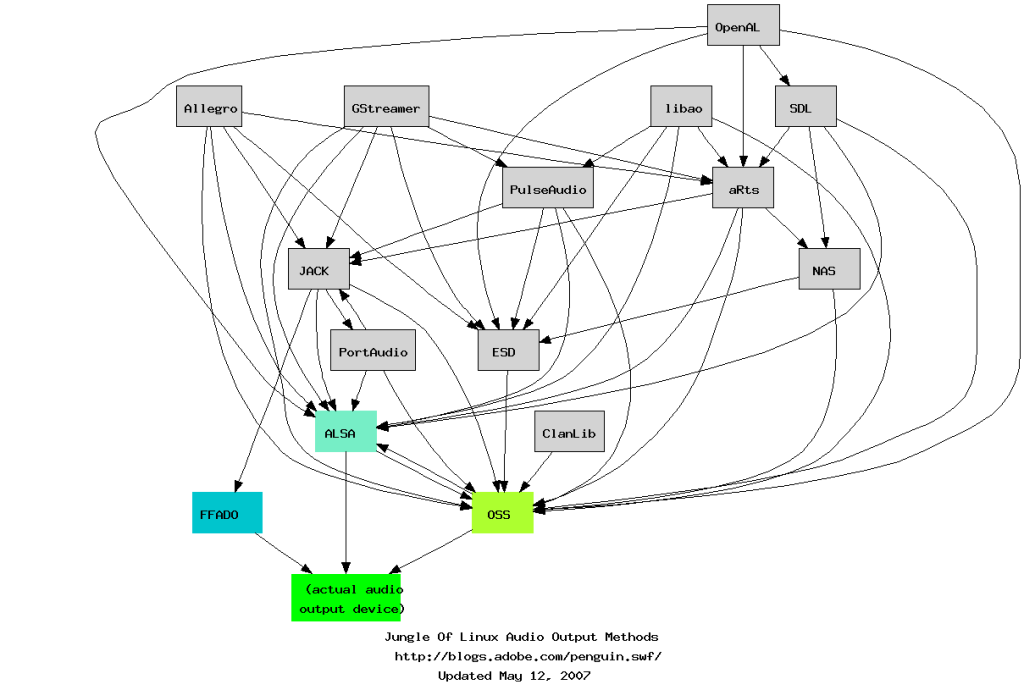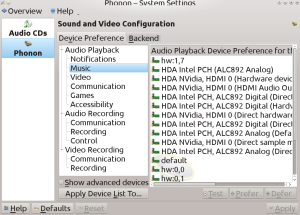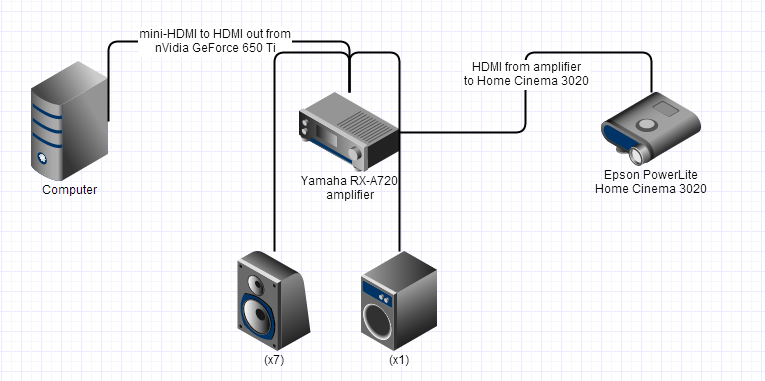Full disclosure: I live with Kayla, and had to jump in to help resolve an enraging problem we ran into on the Kubuntu installation with KDE, PulseAudio and the undesirable experience of not having sound in applications. It involved a fair bit of terminal work and investigation, plus a minimal understanding of how sound works on Linux. TuxRadar has a good article that tries to explain things. When there are problems, though, the diagram looks much more like the (admittedly outdated) 2007 version:

To give you some background, the sound solution for the projection system is more complicated than “audio out from PC, into amplifier”. I’ve had a large amount of success in the past with optical out (S/PDIF) from Linux, with only a single trip to alsamixer required to unmute the relevant output. No, of course the audio path from this environment has to be more complicated, and looks something like:
As a result, the video card actually acts as the sound output device, and the amplifier takes care of both passing the video signal to the projector and decoding/outputting the audio signal to the speakers and subwoofer. Under Windows, this works very well: in Control Panel > Sound, you right-click on the nVidia HDMI audio output and set it as the default device, then restart whatever application plays audio.
In the KDE environment, sound is managed by a utility called Phonon in the System Settings > Multimedia panel, which has multiple backends for ALSA and PulseAudio. It will essentially communicate with the highest-level sound output system installed that it has support for. When you make a change in a default Kubuntu install in Phonon it appears to be talking to PulseAudio, which in turn changes necessary ALSA settings. Sort of complicated, but I guess it handles the idea that multiple applications can play audio and not tie up the sound card at the same time – which has not always been the case with Linux.
In my traditional experience with the GNOME and Unity interfaces, it always seems like KDE took its own path with audio that wasn’t exactly standard. Here’s the problem I ran into: KDE listed the two audio devices (Intel HDA and nVidia HDA), with the nVidia interface containing four possible outputs – two stereo and two listed as 5.1. In the Phonon control panel, only one of these four was selectable at a time, and not necessarily corresponding to multiple channel output. Testing the output did not play audio, and it was apparent that none of it was making it to the amplifier to be decoded or output to the speakers.
Using some documentation from the ArchLinux wiki on ALSA, I was able to use the aplay -l command to find out the list of detected devices – there were four provided by the video card:
**** List of PLAYBACK Hardware Devices ****
card 0: PCH [HDA Intel PCH], device 0: ALC892 Analog [ALC892 Analog] Subdevices: 1/1
Subdevice #0: subdevice #0
card 0: PCH [HDA Intel PCH], device 1: ALC892 Digital [ALC892 Digital] Subdevices: 1/1
Subdevice #0: subdevice #0
card 1: NVidia [HDA NVidia], device 3: HDMI 0 [HDMI 0] Subdevices: 1/1
Subdevice #0: subdevice #0
card 1: NVidia [HDA NVidia], device 7: HDMI 0 [HDMI 0] Subdevices: 1/1
Subdevice #0: subdevice #0
card 1: NVidia [HDA NVidia], device 8: HDMI 0 [HDMI 0] Subdevices: 1/1
Subdevice #0: subdevice #0
card 1: NVidia [HDA NVidia], device 9: HDMI 0 [HDMI 0] Subdevices: 1/1
Subdevice #0: subdevice #0
and then use aplay -D plughw:1,N /usr/share/sounds/alsa/Front_Center.wav repeatedly where N is the number of one of the nVidia detected devices. Trial and error let me discover that card 1, device 7 was the desired output – but there was still no sound from the speakers in any KDE applications or the Netflix Desktop client. Using the ALSA output directly in VLC, I was able to get an MP3 file to play properly when selecting the second nVidia HDMI output in the list. This corresponds to the position in the aplay output, but VLC is opaque about the exact card/device that is selected.
At this point my patience was wearing pretty thin. Examining the audio listing further – and I don’t exactly remember how I got to this point – the “active” HDMI output presented in Phonon was actually presented as card 1, device 3. PulseAudio essentially grabbed the first available output and wouldn’t let me select any others. There were some additional PulseAudio tools provided that showed the only possible “sink” was card 1,3.
The brute-force, ham-handed solution was to remove PulseAudio from a terminal (sudo apt-get remove pulseaudio) and restart KDE, presenting me with the following list of possible devices read directly from ALSA. I bumped the “hw:1,7” card to the top and also quit the system tray version of Amarok.

Result: Bliss! By forcing KDE to output to the correct device through ALSA, all applications started playing sounds and harmony was restored to the household.
At some point after the experiment I will see if I can get PulseAudio to work properly with this configuration, but both Kayla and I are OK with the limitations of this setup. And hey – audio works wonderfully now.


PulseAudio will show that sink if you add the following to /etc/pulse/default.pa:
load-module module-alsa-sink device=plughw:NVidia,7
The reason that it’s not currently working is that udev is not properly handling the audio outputs for the nVidia driver, and/or PulseAudio is starting before these are properly set up in udev.
Thanks – I’ve commented on the original Reddit post but figured I’d follow up here with the fix for anyone else who might be reading this article.
So the instruction worked with a number of other changes:
* reinstalled PA with
sudo apt-get install pulseaudio* removed ~/.asoundrc (well, renamed it in case I had to revert)
* made sure to add the suggested line before the
.ifexists module-udev-detect.sostatement* rebooted the system – no change
* went into Phonon and tested each of the two active devices; moved the GF110 High Definition Audio Controller to the top of the preferences list as in http://thelinuxexperiment.com/blog/wp-content/uploads/2013/08/pa_priority-1024×768.png
* still two problems: “Audio Hardware Setup” defaults to “Built-in Audio” (http://thelinuxexperiment.com/blog/wp-content/uploads/2013/08/pa_nonfunctional_1-1024×768.png) and none of the individual speaker test controls work when selecting any audio output source on the GF110 High Definition Audio Controller (http://thelinuxexperiment.com/blog/wp-content/uploads/2013/08/pa_nonfunctional_2-1024×768.png)
So at least PA is working now, even if not all the test tools are functional.